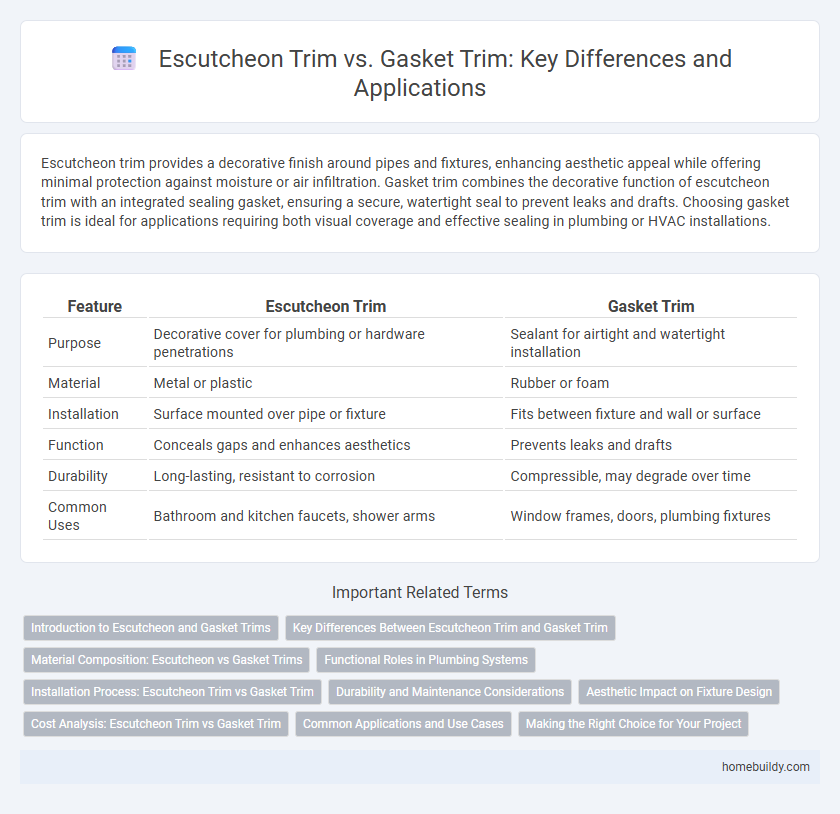Escutcheon trim provides a decorative finish around pipes and fixtures, enhancing aesthetic appeal while offering minimal protection against moisture or air infiltration. Gasket trim combines the decorative function of escutcheon trim with an integrated sealing gasket, ensuring a secure, watertight seal to prevent leaks and drafts. Choosing gasket trim is ideal for applications requiring both visual coverage and effective sealing in plumbing or HVAC installations.
Table of Comparison
| Feature | Escutcheon Trim | Gasket Trim |
|---|---|---|
| Purpose | Decorative cover for plumbing or hardware penetrations | Sealant for airtight and watertight installation |
| Material | Metal or plastic | Rubber or foam |
| Installation | Surface mounted over pipe or fixture | Fits between fixture and wall or surface |
| Function | Conceals gaps and enhances aesthetics | Prevents leaks and drafts |
| Durability | Long-lasting, resistant to corrosion | Compressible, may degrade over time |
| Common Uses | Bathroom and kitchen faucets, shower arms | Window frames, doors, plumbing fixtures |
Introduction to Escutcheon and Gasket Trims
Escutcheon trims serve as decorative plates that cover the gap between plumbing fixtures and walls, offering both aesthetic appeal and protection against water damage. Gasket trims incorporate a built-in rubber or silicone gasket to ensure a watertight seal, preventing leaks and enhancing durability in wet areas. Choosing between escutcheon trim and gasket trim depends on whether the priority is purely visual coverage or added moisture protection.
Key Differences Between Escutcheon Trim and Gasket Trim
Escutcheon trim provides a decorative cover around plumbing fixtures, typically made from metal or plastic, designed to conceal gaps between pipes and walls for a clean finish. Gasket trim includes a rubber or silicone seal that prevents water leakage by creating a tight, waterproof barrier between the fixture and the mounting surface. The key difference lies in functionality: escutcheon trim focuses on aesthetic appearance and gap coverage, while gasket trim emphasizes sealing and preventing moisture intrusion.
Material Composition: Escutcheon vs Gasket Trims
Escutcheon trims are typically made from durable metals such as stainless steel, brass, or chrome-plated alloys, providing corrosion resistance and an attractive finish for plumbing or door hardware. Gasket trims combine a metal outer ring with an inner rubber or silicone gasket, enhancing waterproof sealing and vibration absorption around pipes or fixtures. The material composition of escutcheon trims prioritizes aesthetics and durability, while gasket trims emphasize functional sealing properties through their integrated elastomer components.
Functional Roles in Plumbing Systems
Escutcheon trim primarily serves as a protective and decorative cover around plumbing fixtures, concealing pipe penetrations and preventing dirt or debris from entering wall or floor openings. Gasket trim combines sealing capabilities with aesthetic coverage, creating a watertight barrier that prevents leaks and protects structural materials from moisture damage. In plumbing systems, escutcheon trim emphasizes visual finish and surface protection, while gasket trim prioritizes leak prevention and system integrity.
Installation Process: Escutcheon Trim vs Gasket Trim
Escutcheon trim typically installs by sliding over the pipe and securing to the wall with screws or adhesive, offering a clean and polished finish. Gasket trim involves placing a flexible gasket around the pipe, often requiring compression or snap-fit techniques to create a watertight seal during installation. The escutcheon trim installation prioritizes aesthetic coverage, while gasket trim focuses on sealing and protection against moisture infiltration.
Durability and Maintenance Considerations
Escutcheon trim, typically made from metal or high-quality plastic, offers superior durability and resists cracking or warping over time compared to gasket trim. Gasket trim provides a secure seal but may degrade or become brittle, requiring more frequent replacement and maintenance. In terms of upkeep, escutcheon trim is easier to clean and maintain, making it a longer-lasting choice for plumbing and HVAC applications.
Aesthetic Impact on Fixture Design
Escutcheon trim provides a sleek, polished aesthetic that enhances the overall appearance of a fixture by seamlessly covering holes and rough edges, creating a clean, finished look. Gasket trim, while functional in providing a watertight seal, tends to prioritize utility over visual appeal and may appear bulkier or less refined compared to escutcheon trim. Selecting escutcheon trim over gasket trim contributes to a more sophisticated fixture design, making it ideal for spaces where visual impact and style are paramount.
Cost Analysis: Escutcheon Trim vs Gasket Trim
Escutcheon trim typically offers a more cost-effective solution compared to gasket trim due to lower material and manufacturing expenses. While gasket trim provides enhanced sealing capabilities, its complexity and specialized materials contribute to higher overall costs. Choosing between escutcheon and gasket trims requires balancing budget constraints against performance requirements, with escutcheon trim favored for economical installations.
Common Applications and Use Cases
Escutcheon trim is commonly used in bathroom sinks and faucets to cover holes and provide a polished look, while gasket trim serves as a seal to prevent water leaks and protect against moisture damage. Escutcheon trim is ideal for decorative purposes on exposed plumbing fixtures, whereas gasket trim is essential in plumbing connections requiring watertight seals. Both trims are widely applied in residential and commercial plumbing systems to enhance durability and aesthetic appeal.
Making the Right Choice for Your Project
Escutcheon trim offers a polished, decorative finish ideal for enhancing the appearance of faucets and plumbing fixtures, while gasket trim provides a watertight seal essential for preventing leaks and ensuring durability. Choosing between escutcheon trim and gasket trim depends on project priorities such as aesthetic appeal versus functional protection against moisture. Selecting the right trim involves evaluating installation requirements, material compatibility, and long-term performance to achieve optimal results.
Escutcheon Trim vs Gasket Trim Infographic

 homebuildy.com
homebuildy.com